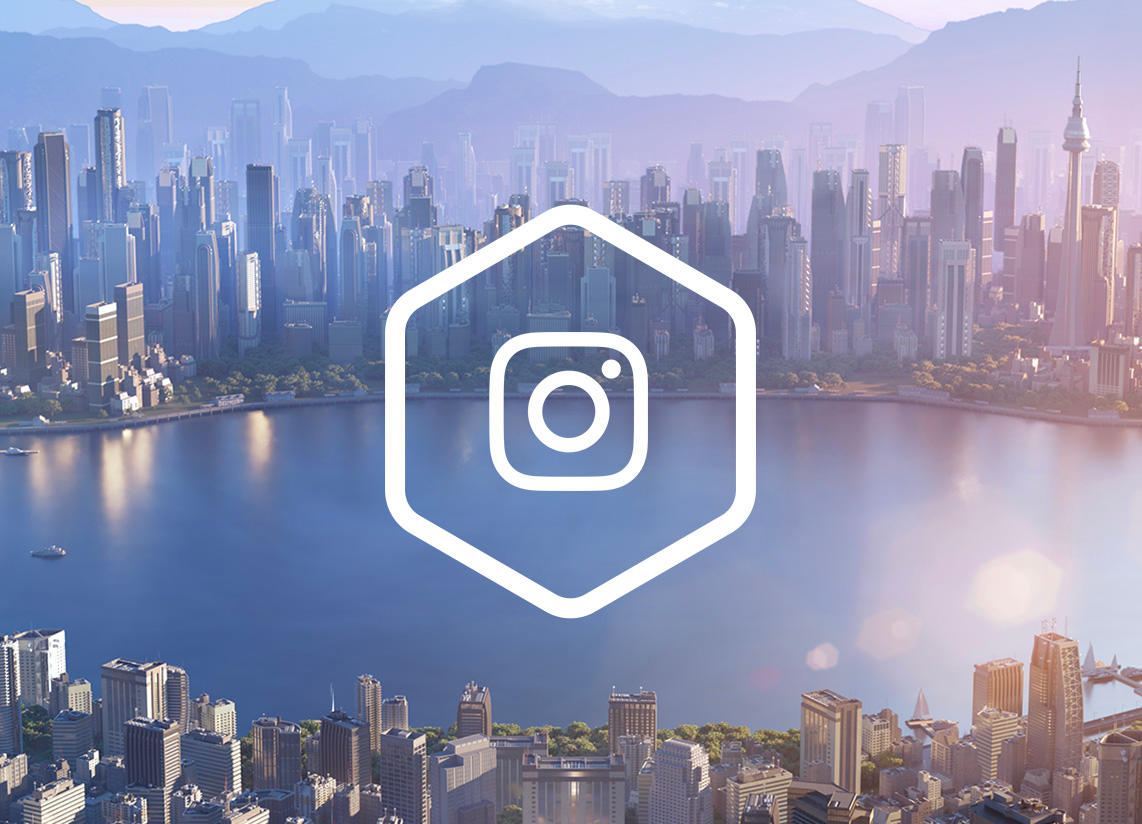Cities: Skylines II Feature Highlight #6: Electricity & Water
Hi everyone! It's time for the next development diary for Cities: Skylines II and today we dive deep into the Electricity and Water services! Almost all buildings need electricity and water to function properly so these services are the components to running a city. For citizens, a lack of electricity or water leads to reduced Well-being, with a lack of water and backed-up sewage also taking a toll on their Health. Don’t leave them without these basic necessities for long as they will not tolerate it and will leave the city. Businesses and service buildings suffer a penalty for their Efficiency leading to reduced production or output and lower quality services. So let’s get into how these vital services function. Creating electricity and water networks is different in Cities: Skylines II compared to its predecessor as both can now be transferred through roads. While electricity was transferred by connecting power lines between power plants and electricity “zones” created around buildings in Cities: Skylines, buildings now connect to the electricity grid through either above-ground or underground cables. Meanwhile, surface water and water pumps work similarly in both games, Cities: Skylines II introduces a new water mechanic in groundwater reservoirs. Check out the video for a quick overview or dive straight into all the details!
Electricity Production
There are various ways to provide the city with electricity. Electricity can be produced locally in the various power plants. Electricity can also be traded with Outside Connections through power lines. If there's an electricity deficit, the city automatically buys electricity from the neighboring cities if the city is connected to the power line leading to Outside Connections. If the city produces excess electricity, it can in turn be sold to Outside Connections through to power line connection. Importing electricity is quite costly but can help during electricity usage spikes. Exporting electricity can cover the production costs partially. Emergency Battery Stations and battery upgrades for certain power plants can be used to store excess electricity produced in the city for when the city experiences a spike in electricity usage.
Producing electricity locally is a good way to ensure your city’s needs are met while saving on costs that importing power would bring. The different power plants can be divided into different categories based on what type of resource they use to produce electricity: fossil fuels, renewable energy, and nuclear. Fossil fuel power plants use coal, oil, or gas to produce electricity, which can be produced locally in Specialized Industry areas (Ore and Oil) or imported from Outside Connections. Power plants using renewable sources get their energy from solar, wind, geothermal, and water.
The demand for electricity increases as the city grows but it is also affected by changes in the temperature, with both hot and cold weather increasing consumption. On hot days the city needs air conditioning to cool down and when it's cold outside heating increases the amount of electricity used. Consumption is at its lowest when the weather is neither too hot nor too cold.
Transformers
In Cities: Skylines II there are two types of electricity: low voltage and high voltage. Electric cables are used to transfer the low voltage electricity used by the buildings of the city and can be manually placed above ground or underground. Most of the road types include built-in low voltage cabling, automatically connecting buildings along the road to the electric grid. Electric cables have a low electricity capacity meaning that they alone cannot transfer all the electricity produced by the large power plants which is where high voltage comes into play.
Power lines are used to transfer the high voltage electricity produced by power plants and they have higher electricity capacity which enables them to transfer large amounts of electricity. They are also used to import or export electricity from neighboring cities through Outside Connection. Power lines can be manually placed above ground or underground and they can be connected to low-voltage electric cables and roads with a Transformer Station. Here high voltage electricity is transformed into low voltage electricity that can be used by the buildings of the city, but it can also transform low voltage electricity to high voltage for export. A Transformer Station can have multiple power line connections and multiple electric cables connected to it, but it has a limited capacity of how much electricity can be transformed in total.

Transform high voltage to low voltage or vice versa with a Transformer Station
Emergency Battery Station
An Emergency Battery Station stores electricity by charging the batteries when the city’s electricity production is higher than its consumption allowing the stored electricity to be used to avoid blackouts if consumption spikes. When there is a lack of electricity in the city the Emergency Battery Station starts discharging the batteries. The batteries can be used in conjunction with the Solar Power Plant to power the city during the night when the Solar Power Plant doesn’t produce electricity.

Prepare for spikes in electricity consumption with an Emergency Battery Station
Wind Turbine
A Wind Turbine is the cheapest renewable energy source to build but it has a comparatively low output. It generates low voltage electricity from wind currents and its power output depends on its placement on the terrain. When placing a Wind Turbine there will be a notification telling you how much electricity would be produced in the current spot. A Wind Turbine can be placed roadside, on the ground, or on water. If placed elsewhere but roadside, it needs to be connected with the electric cable to the electricity grid. It is a good choice for small cities in windy locations.

Go green and power your city with Wind Turbines - if the wind is strong enough
Small Coal Power Plant
A basic power plant that is cheap to build, affordable to maintain, and available in the early game, but also one that generates a large amount of pollution and requires coal as fuel to produce electricity. Unlike many of the other power plants, the Small Coal Power Plant cannot be upgraded.

The Small Coal Power Plant is a cheap option for a small town looking to produce electricity locally
Gas Power Plant
The Gas Power Plant is larger and more efficient than coal power plants and it is fueled by natural gas. Gas can be produced in the city using the Specialized Industry areas to extract oil and refine it into petrochemicals used by the power plant. It’s a slightly less cost-efficient way to produce electricity but it produces a bit less pollution than coal power plants.

Turn petrochemicals into electricity with the Gas Power Plant
Coal Power Plant
The Coal power plant has all the same features as the Small Coal Power Plant but everything is bigger, of course. When the city grows and the electricity consumption increases, the Small Coal Power Plant’s electricity production is no longer enough and you will need to expand your production. That’s where the Coal Power Plant shines as its electricity production is significantly larger and it is cheaper to build and maintain one Coal Power Plant than the amount of Small Coal Power Plants that are required to get the same electricity output.

Power your city with the Coal Power Plant and upgrade it as your city grows
Geothermal Power Plant
As a renewable energy source, the Geothermal Power Plant converts heat from deep underground turning it into electricity. The power plant doesn’t need fuel to operate but it requires groundwater deposits to function and it doesn't create as much pollution as coal power plants. The downsides of this power plant are that it is somewhat expensive to build and maintain and it also pollutes the groundwater deposit making it unusable for drinking water.

Harness the heat deep underground with the Geothermal Power Plant
Solar Power Plant
The Solar Power Plant is another source of renewable energy which converts sunlight into electricity. However, its output depends on the time of day and the latitude of the map. As this power plant requires sunlight to function it does not produce electricity during the night, but has a small integrated battery that can release some of the charged electricity at night time. This power plant only produces noise pollution making it a green option, however, it is expensive to build and maintain, and as the power output depends on the weather the production of electricity isn't stable.

The Solar Power Plant is a great green option for electricity production but consider combining it with an Emergency Battery Station
Nuclear Power Plant
A thermal power plant that uses nuclear fission as the source of heat. This power plant produces huge amounts of electricity and it doesn't use any type of fuel to operate. The only pollution it produces is high noise pollution, which makes it sound almost too good to be true, but of course, there are some downsides. It is very expensive to build, has a high upkeep cost, and consumes large amounts of water for cooling, so make sure your water supply and your economy are in good shape before adding a Nuclear Power Plant to your city.

It may be expensive but the Nuclear Power Plant produces a lot of electricity and doesn’t pollute the ground or air
Hydro-Electric Power Plant
A Hydro-Electric Power Plant generates electricity from flowing water and offers a renewable source of energy that only produces noise pollution. Its output depends on the speed of the water flowing through its turbines and how stable its electricity generation is depends entirely on the water simulation. Flowing water, such as rapid rivers with steep elevation differences, are great spots to build dams. The size of the dam determines both its cost and electricity production.
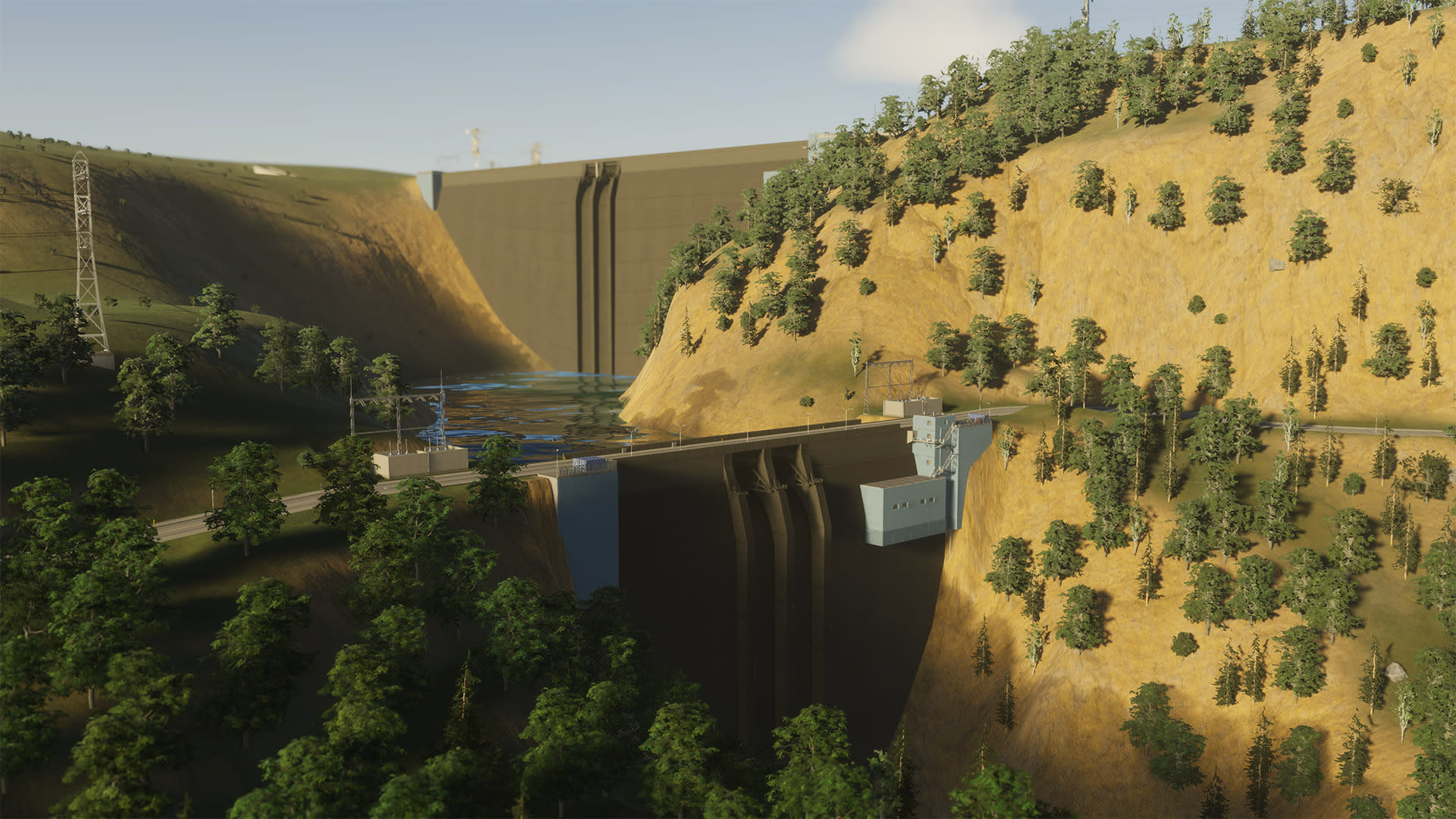
Take advantage of the rivers on the map with the Hydro-Electric Power Plant
Fuel Logistics
Fuel for power plants can be extracted locally using Specialized Industry areas or it can be imported from Outside Connections, each with both benefits and downsides. Local fuel extraction will generate less truck traffic between the city and Outside Connections, however, producing different fuel types locally is quite pollutive and it takes up a lot of space.
If the fuel is imported from Outside Connections there won’t be pollution from Specialized Industry areas in the city, but there will be more traffic between the power plants and Outside Connections. In the long run, it is more expensive to buy fuel instead of producing it yourself.
In both cases, it is important that the road network is built to handle the transportation between the fuel production or Outside Connection and the city's power plants. Fuel shortages can occur if trucks cannot make it in time to the power plants before they run out of fuel. And, of course, fuel costs are added to the power plant’s upkeep cost.
Power Plant Upgrades
In the previous development diary, City Services, we discussed how building upgrades can add new or expand the existing functionalities of a service building. They cost money to build and, in most cases, they also increase the building’s upkeep cost.
Most of the electricity service buildings have upgrades to modify their functionality through three types of upgrades: operational, extensions, and sub-buildings. The upgrades affect various aspects, such as the buildings’ capacity, output, and the amount of pollution the building is producing. For example, the Gas Power Plant has four different upgrades: Storage Extension, Advanced Furnace, Exhaust Filter, and Additional Turbine. The Storage Extension allows the plant to store more fuel resulting in it needing fewer deliveries, and as it is a sub-building, you can build multiple extensions if needed. The Advanced Furnace is an operational upgrade that reduces the fuel consumption of the plant, while the Exhaust Filter reduces the building’s air pollution. An Additional Turbine provides an extension upgrade that allows the plant to produce more electricity, though it also increases both its fuel consumption and pollution output.
Multiple upgrades give you more tools to design the city you want. Some upgrades take up more space and increase the upkeep cost so it is up to you to decide which upgrades fit the building's use and the city’s current needs. If the building is far from residential areas and downwind, it is not critical to reduce the pollution of the building, while it may be beneficial if the air pollution is affecting citizens. The building’s location and connections to the electricity network determine the usage of the building, and if the usage is low, upgrades that improve capacity and productivity may not be needed just yet. However, excess electricity can always be traded to Outside Connections if the situation rises. The city’s electricity usage can also be increased by lowering the electricity fee as this causes the citizens to use more electricity per household while also increasing their Happiness and the Efficiency of companies.

The Coal Power Plant fully upgraded with an additional turbine, advanced furnace, exhaust filter, and an additional coal storage yard
Electricity Distribution
As mentioned electricity is no longer a matter of connecting “electric zones” created by buildings, but instead providing your city with a robust power grid. Power plants and Transformer Stations feed electricity directly into the grid through electric cables and these can be connected through the high voltage power lines. Each power line and electric cable has a maximum capacity which determines how much electricity they can carry. When that capacity is reached a bottleneck forms creating a disturbance in the distribution of electricity. Every building is connected to the electric grid automatically when they are built or zoned alongside roads, while buildings not placed roadside need to be connected manually.
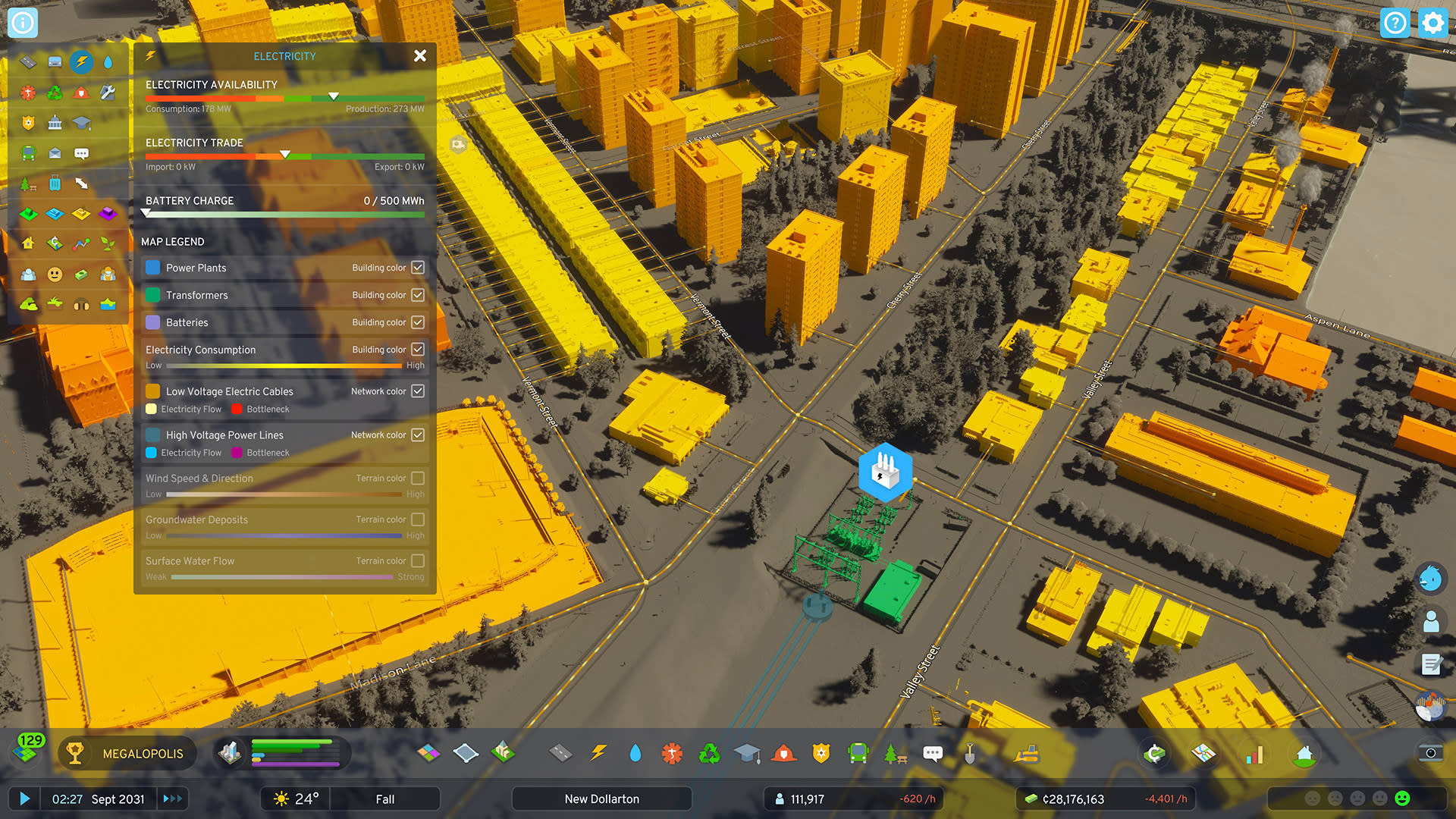
Power is distributed through electricity cables under roads and buildings are automatically connected when built next to roads
Electricity Bottlenecks
These occur when an area of the city requires more electricity than the grid can currently distribute. This results in buildings in that area losing power as the electric grid cannot support all of them, and this happens when the area in question only has a few connections to the rest of the city’s power grid.

Electricity bottlenecks form when a power line or electricity cable reaches its limit The solution is simple: provide the area with more electricity connections so more power can be distributed to it. You can build more roads or low voltage connections using electric cables, or you can use Transformer Stations and power lines to circumvent the bottleneck area entirely. Placing a Transformer Station on the other side of the bottleneck where electricity can be distributed through multiple routes and then connecting it with a power line directly to the power plant allows additional electricity to be distributed into the area beyond the bottleneck.
Electricity Info View
The Electricity info view includes illustrative and relevant information about the electricity grid of the city giving you a quick overview. You can see both the city’s current consumption and how much electricity is produced by the power plants with the Electricity Availability meter, while the Electricity Trade meter shows if any electricity is imported from or exported to Outside Connections. And the Battery Charge meter shows the amount of electricity currently stored in the batteries of your power plants and Emergency Battery Stations.
The info view includes many visual elements, such as the electricity flowing through low and high voltage cables and in which direction the electricity is flowing. Hovering over the power lines and electric cables with the mouse cursor shows how much electricity is transmitted and the maximum capacity of the power lines and cables. The buildings that consume electricity are shown in different tones of yellow and orange based on how high their consumption is, while power plants, transformers, and batteries are highlighted in different colors. The other visual additions like wind speed arrows, groundwater deposits, and water flow arrows, can be turned on and off as needed.
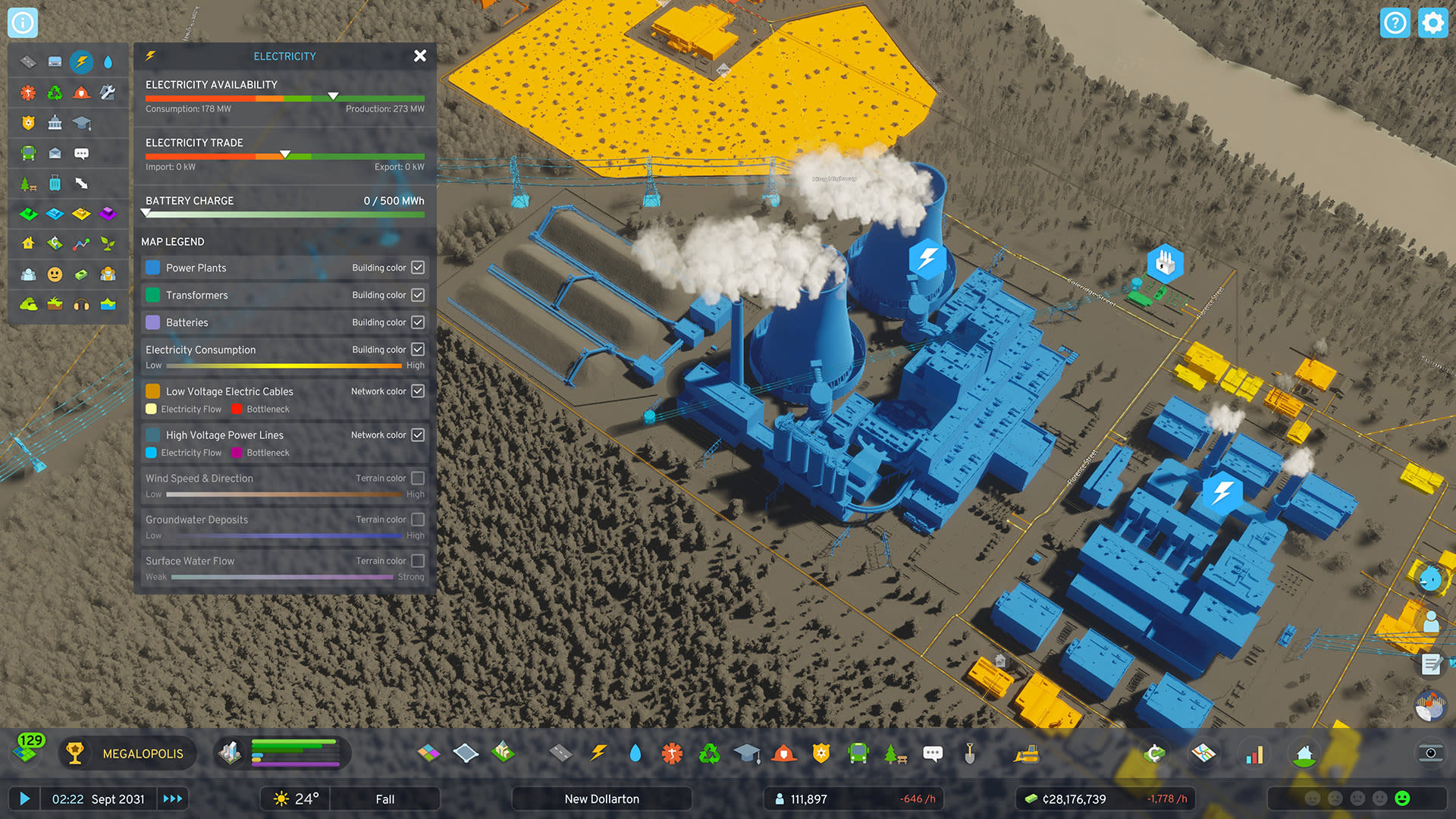
Track your city’s electricity with the info view or use it to locate power plants and transformers
Water Sources
There are two types of water sources in Cities: Skylines II. Surface water is familiar to the previous game and includes dynamic, flowing rivers, lakes, and vast oceans. Groundwater is an entirely new feature and expands the possibilities of water and sewage gameplay!
Surface Water
Open, dynamic water areas are a trademark of the Cities: Skylines franchise. They are present on every map in the game in the form of rivers, lakes, or oceans, and depending on the map, they all feature water flow of different strengths. Lakes and oceans tend to have minimal flow while rivers carry large amounts of water from their sources to river deltas at the shores of lakes and oceans.
Water flow is an integral part of the surface water gameplay as it determines how water is obtained and where the polluted sewage from Sewage Outlets ends up. Surface water is susceptible to water pollution so it is important to plan the placement of both the Water Pumping Station and Sewage Outlet to avoid contaminating your water supply. Inspecting the Water infoview and its Surface Water Flow overlay gives you information about the direction and strength of the water flow on the map.
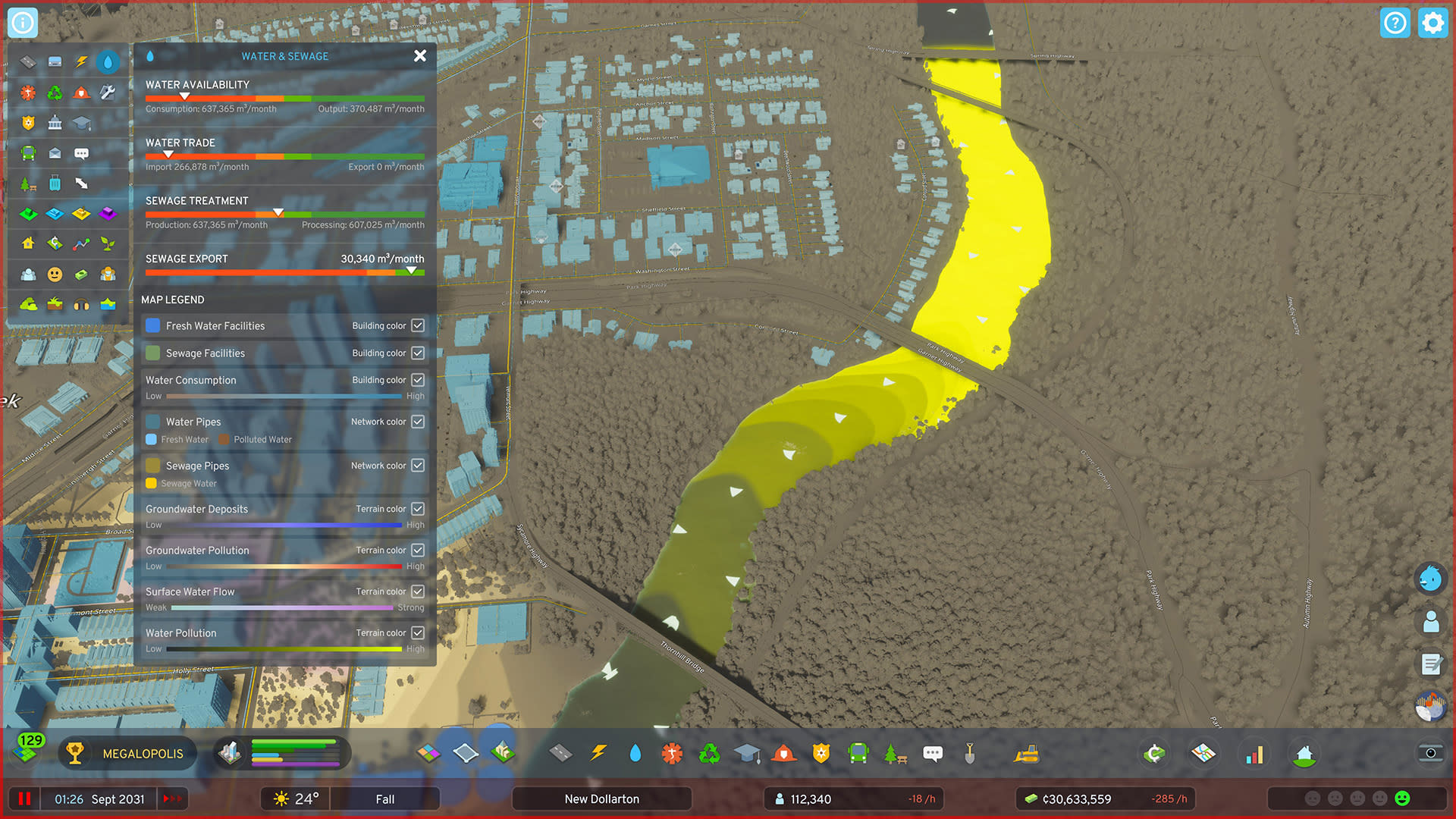
Watch the water flow when placing sewage outlets or water pumping stations
Groundwater
Groundwater is a brand new feature in Cities: Skylines II. Like surface water areas, groundwater is featured on every map and the groundwater deposits are accessible through the Groundwater Pumping Station. The groundwater deposits have a replenishment rate which refills their water level over time. However, unlike surface water areas, groundwater deposits can temporarily dry up if their usage is higher than their replenishment rate. The deposits will eventually fill back up if water pumping is halted or reduced by lowering the budget and thereby the building’s efficiency.

Groundwater deposits can be found throughout the map Groundwater deposits are very susceptible to ground pollution. If the deposit comes into contact with ground pollution, it starts to become contaminated, leading to dirty water being pumped into the water system. Once the ground pollution is removed, the pollution in the groundwater deposit also decreases until it is entirely clean once again. The rate at which the deposit is decontaminated is the same as its water replenishment rate.

Pollution spreads to an entire deposit once it comes into contact with polluted ground Groundwater usage is an equally viable way to bring water to the city and a great alternative to Water Pumping Stations when a map features a limited amount of surface water areas. Additionally, Geothermal Power Plants require groundwater deposits to produce electricity in the city.
Water Production & Sewage
Clean water is a crucial resource in a functioning city, and in general, the city produces as much sewage as the amount of water it consumes. Buildings require water to perform their basic functions and citizens require it to be able to live in the city. Water can be pumped from surface water areas as well as from groundwater deposits located underground.
Sewage treatment is equally important for the city and its citizens as insufficient sewage infrastructure causes used, dirty water to back up in the pipes, flooding apartments and causing citizens to become sick and negatively affecting business’s Efficiency.
Pipes
Water infrastructure is built-in into most road types, similar to electric cables, though pipes do not have a capacity to keep an eye on. Both water and sewage pipes are automatically connected to all the buildings constructed alongside roads. Buildings that don’t require road access can be connected with separate underground pipes, either single pipes for water or sewage and as a combined water-sewage dual pipe. Pipes are built using similar tools to roads and can be replaced with different types if needed.

Water and sewage connections happen automatically for roadside buildings
Water Pumping Station
The Water Pumping Station pumps water from surface water areas, such as lakes, rivers, and the ocean. It is placed on the shoreline and has a stable output of water unless the water level drops significantly.

Supply your city with water from lakes or rivers using the Water Pumping Station
Water Tower
The Water Tower is able to provide a limited amount of water while placed anywhere on the map and isn’t affected by any type of pollution. However, its biggest downside is that it is very costly to maintain compared to the other water facilities.

Water Towers can be placed anywhere but can only provide a limited supply of water
Groundwater Pumping Station
Maps have underground water reservoirs and the Groundwater Pumping Station is able to access these. It needs to be placed on top of a groundwater deposit to pump water up from underground supplying your city with water. Groundwater is a good alternative on maps that have limited surface water areas where dealing with sewage is more challenging.

Place a Groundwater Pumping Station on a groundwater deposit to supply your city with water
Advanced Water Pumping Station
The Advanced Water Pumping Station is a unique building with a high output of water. Similar to the regular Water Pumping Station, it is placed on the shoreline, however, its water pumping rate is tenfold compared to the other pumping stations making it a much more cost-effective option for a large city.

When your city’s need for water increases the Advanced Water Pumping Station provides a great option for clean water
Sewage Outlet
A Sewage Outlet pumps dirty water directly back into surface water areas. It is built on the shoreline and connected to the city through a sewage pipe. The Sewage Outlet doesn’t have a water treatment functionality so the output is 100% contaminated water, though this can be reduced to a degree through its upgrades. It is important to plan the placement of Sewage Outlets so that they do not contaminate areas of the water where the city pumps up clean water.

A Sewage Outlet is cheap and efficient but lets out much pollution
Wastewater Treatment Plant
The Wastewater Treatment Plant processes sewage, purifying it so it can be reused as clean water for the city. Pollutants are removed from the water and turned into solid waste which is then collected by garbage trucks and transported to one of the city’s waste management facilities.

Treat your wastewater inland with the Wastewater Treatment Plant and avoid polluting your lakes or rivers
Water Facility Upgrades
Like other city services, the upgrades for water facilities include operational upgrades, building extensions, and sub-buildings. These upgrades add capacity and new functionality to the buildings, increasing freshwater and sewage output as well as adding water treatment capabilities for both water pumps and sewage facilities to help you combat pollution.
As an example of operational upgrades, the Groundwater Pumping Station can be upgraded with an Advanced Filtering System reducing pollutants in intake water, and the Sewage Outlet can benefit from Chemical Purification to reduce its water pollution. Both the Water Pumping Station and the Groundwater Pumping Station can increase their water intake through building extensions, and the Wastewater Treatment Plant can increase its processing capacity through one or more Extra Processing Unit sub-building upgrades.
Water & Sewage Info View
Last item on our list today is the Water & Sewage info view. It highlights the location of both water and sewage service buildings and provides informative elements that are not otherwise visible. Similar to the Electricity info view you have the Water Availability meter which shows the city’s current water consumption and production serving as a quick overview of your city’s water needs. You can also keep an eye on Water Trade to see how much water is imported from or exported to Outside Connections. Sewage, of course, has its own two meters bringing you all the information you need to determine how well your sewage system is holding up.
Under the meters is the selection of different visual elements which can be enabled or disabled on the info view. For example, water and sewage pipes, shown in blue and yellow, also display which way the water is moving in the pipe network. The polluted water and polluted groundwater deposits are colorful and easy to notice in the info view, and the arrows help to illustrate which direction the water is flowing.

Check water flow, groundwater deposits, water pollution, and more with the Water & Sewage info view With that information in hand, you should be prepared to provide your citizens with these important services. What new additions are you looking forward to experiencing in Cities: Skylines II? Let us know in the comments below. And if you missed it, don’t forget to check out last week’s development diary covering City Services where we covered all the services coming in the game. Next week is all about maps as we explore the landscapes which will serve as the foundation for your cities, including their size and themes, so stay tuned.







